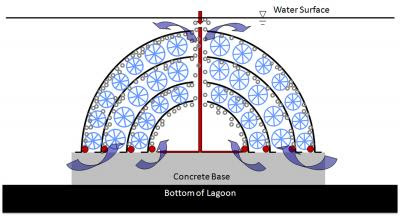In many of the ecology and alternative energy circles there is robust chatter about a less expensive means to handle wastewater.
If you search for "sewage bio-domes" on the web, you'll find examples and pictures such as the one above. Nicknamed "Poo-Gloos" because of their shape, these little guys can clean up sewage just as effectively as multimillion-dollar treatment facilities for towns outgrowing their waste-treatment lagoons.
I bring this up because of the recent housing developments in the Hudson Valley including Ulster County. One of the main obstacles in the planning process for Hudson Landing in Kingston, was the threat of exceeding out treatment plant capacity in the possible future.
What to do with additional sewage is an important and challenging engineering task. Proper treatment includes disinfection and the removal of unwanted pollutants. We may have an efficient system here in Kingston, but most rural communities with municipal systems rely on wastewater lagoons as their primary method of treatment.
So here I present an idea for future development in Ulster County. These underwater domes are filled with sewage-eating bacteria and considered a less-expensive, lower-impact alternative to wastewater treatment facilities.It's also noted that they treat the same amount of pollutant as the big mechanical treatment plants.
The examples I've shown here are from an American company based in Salt Lake City. The company, which seems to be getting all the attention is Wastewater Compliance Systems. Their director of sales was quoted in the treatment journals was: "Every day I speak with community officials who need to upgrade their treatment facilities. They come to us because they receive an engineering report recommending a $4-10 million mechanical plant project that is impossible for them to pay for with their existing tax base. Not only can our Poo-Gloos or Bio-Domes help communities comply with pollution limits, but most of the projects I quote cost between $150,000 and $500,000, and the operating expenses are a fraction those at a mechanical plant."
InHabitat.com described the domes in detail. Each of which have four domes inside of them, separated by plastic film, allowing for a large area for the growth of bacteria, which cleans up the wastewater. The domes are placed at the bottom of a sewage treatment lagoon, and tubes move air through the domes, moving water through them as well.
The Bio-Domes are now being used in six states, in both pilot projects and full-scale installations. Is there any way of tapping into the pilot project status to get an even better deal? I don't know, but it's worth looking into. As projects come to our attention in the County Legislature, the Environmental sub-committee of the GOE should encourage innovative treatment projects such as this. I think my colleagues would agree.
Thursday, January 13, 2011
Subscribe to:
Post Comments (Atom)


4 comments:
These look like something from a SciFi movie. I can see aliens sneaking out at night and grabbing people. Wait, could this be a great screenplay or what?
They picture is actually eggs cups placed on pavement but Kingston has no chance for developemnt without adequate Water and especially Sewer that won't discharge poop into the sloop clearwater. The Mayor never got a committment for funding from the developer for the Sewer Treatment Impact like most communities do.
Water is basic to life. It is a precious resource and has become precious commodity now. On going Industrialization, population & urbanization pose pressure on water availability. Utility value of world’s freshwater resources like lakes and rivers are diminishing rapidly due to over exploitation & pollution....
The igloo-shaped devices, officially named Bio-Domes, offer an affordable, sustainable way to clean up sewage just as effectively as multimillion-dollar treatment facilities was designed by Kraig Johnson. This is one of the cost-effective ways for water treatment.
Post a Comment